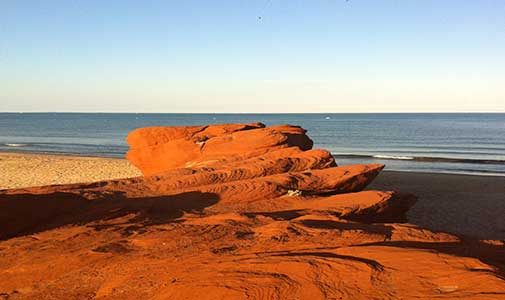When Maria Johnson, of New England, and Cameron, her husband of 35 years, went on a cruise up Canada’s Atlantic coast, they were excited by the prospect—neither of them had ever left the U.S. before.
As Maria and Cameron approached retirement, they realized they needed to wrap up a lot of things, both in their careers and in their personal lives. They’d decided to downsize, so selling the house where they’d raised their children was on their to-do list. But they weren’t sure yet what the next move would be.
Little did they know that their cruise would shape the rest of their lives. On it, they discovered the Magdalen Islands, a tiny Canadian archipelago formed by eight major islands and 200 miles of white sand dunes with red sandstone outcrops.
The scenery is spectacular, with rounded green hills and valleys flanked by bright red cliffs. The white sand beaches and the ocean stretch as far as one can see. It all made Maria feel she’d reached the end of the world. Her first thought was, “Wow, there is so much space here.”
Cameron likes going on fishing trips for mackerel.
The Îles-de-la-Madeleine sit in the middle of the Gulf of Saint Lawrence, near Canada’s Maritime Provinces: Prince Edward Island, New Brunswick, and Nova Scotia. While they may seem remote, their geographical location only adds to their appeal.
“This place gives us such a sense of freedom, an exhilarating feeling of having landed on a different planet, where time is endless and where humans live in harmony with nature,” Maria says.
“I never slept so well in my life as the couple of days we were in the islands during that cruise,” says Cameron. “And the people here are so friendly, so welcoming, we really do feel at home. You would never guess it, but there is so much to do here.”
There is, in fact, an array of activities for all sorts of interests. If you enjoy birdwatching, you can see and photograph some very rare species. Fresh wild berries, which can be turned into jams, pies, and desserts, grow in the summer and fall. A selection of eateries and cafés ranges from casse-croûtes (snack shacks) that offer delicious lobster rolls with French fries on their menus, to high end restaurants serving fresh seafood, local meat, and tasty meals made of local ingredients, such as the pied-de-vent—a savory raw milk cheese made locally.
Several musicians and artists live on the islands. The Johnsons enjoy a wide variety of original local artisan shops, museums, and art galleries, as well as live music concerts, some as simple as a singsong around a bonfire on the beach. The weekly farmers’ market abounds with locally grown organic vegetables, honey produced from the islands’ wildflowers, and local cheeses, jams, and preserves.
L’Abri de la Tempête, the local brewery, offers distinct beer varieties. For wine lovers, Domaine des Salanges, the local vineyard, is a great place to visit to understand how specific grape varieties can grow in the islands’ climate.
Over the years, the islands have slowly become a coveted place for retirement.
That’s due to their simple and healthy lifestyle, tranquility, landscape, and the friendly community of around 14,000.
The main language on the archipelago is French, but the younger generation is quite fluent in English. The islands’ climate is mild, due to huge water masses that circle the archipelago and temper the weather during each season. Midsummer temperatures average around 80 F to 86 F and the water temperature around the archipelago can reach 64 F.
House prices vary, depending on the style, the size, and the location. But you can buy a cozy, colorful, two-bedroom house with an ocean view for as little as $113,000. The cost of imported goods is a little higher than on the mainland, due to transport, but supermarket prices are reasonable, and the in-store bakery at the Coop in Havre-aux-Maisons is a local favorite. Its savings club is a useful way to economize (40 7-ounce packs of fruit juice for $7.50 is a recent deal for members). Plus, you will find the cheapest fresh fish and lobster in North America.
“Life here is stress-free, properties are much cheaper than in the U.S., and learning a little French has kept our minds stimulated,” Maria says. “We still have a lot of work ahead of us before becoming fluent, but we can get by.” Maria has learned how to make pot-en-pot, a classic dish from the islands (a close cousin of the meat pie but prepared with seafood). Cameron likes going on fishing trips for mackerel with his neighbor and bringing back some fish to grill on the barbecue.
Healthcare is readily available; there is a main hospital on the central island of Cap-aux-Meules, some health clinics, and home healthcare services.
Maria and Cameron spend most of their summers on the islands, when the weather is best, and they love the liveliness of the tourist season. The couple also love the winter months, when the ice freezes around the archipelago and the low sun reflects off ice sculptures naturally carved by the water and wind. They go for long walks on the ice and take hundreds of pictures.
Nothing beats sitting on the deck savoring their dinner paired with a local beer, while watching the sun set over the ocean to the west. Cameron says, “Moving to the Îles-de-la-Madeleine was the best decision we ever made.”


